On-Line Corrosion Monitoring of Plate Structures Based on Guided Wave Tomography Using Piezoelectric Sensors
Abstract
:1. Introduction
2. Monitoring System
2.1. Array System and Experimental Setup
2.2. Imaging Algorithm
2.3. Data Processing and Inversion
3. Scattering from Transducers and Its Effect on the Thickness Reconstruction
3.1. Scattering from Transducers
3.2. Scattering Effect on the Reconstruction
4. Experimental Simulation of Corrosion Damage
4.1. Forced Electrochemical Corrosion
4.2. Thickness Measurement Using Laser Profilometry
5. Results and Discussion
5.1. Wall Loss Monitoring
5.2. Thickness Reconstruction
6. Conclusions
Acknowledgments
Author Contributions
Conflicts of Interest
References
- Roberge, P.R. Corrosion Inspection and Monitoring; John Wiley: Hoboken NJ, USA, 2007. [Google Scholar]
- Rocchini, G. Corrosion rate monitoring by the linear polarization method. Corros. Sci. 1993, 34, 2031–2044. [Google Scholar] [CrossRef]
- Cuevas-Arteaga, C.; Uruchurtu-Chavarin, J.; Porcayo-Calderon, J.; Izquierdo-Montalvo, G.; Gonzalez, J. Study of molten salt corrosion of HK-40m alloy applying linear polarization resistance and conventional weight loss techniques. Corros. Sci. 2004, 46, 2663–2679. [Google Scholar] [CrossRef]
- Zarrok, H.; Zarrouk, A.; Hammouti, B.; Salghi, R.; Jama, C.; Bentiss, F. Corrosion control of carbon steel in phosphoric acid by purpald—Weight loss, electrochemical and XPS studies. Corros. Sci. 2012, 64, 243–252. [Google Scholar] [CrossRef]
- Yan, F.; Royer, R.L.; Rose, J.L. Ultrasonic guided wave imaging techniques in structural health monitoring. J. Intell. Mater. Syst. Struct. 2010, 21, 377–384. [Google Scholar] [CrossRef]
- Wang, D.J.; Zhang, W.F.; Wang, X.Y.; Sun, B. Lamb-Wave-Based Tomographic Imaging Techniques for Hole-Edge Corrosion Monitoring in Plate Structures. Materials 2016, 9, 916. [Google Scholar] [CrossRef] [PubMed]
- Cegla, F.B.; Cawley, P.; Allin, J.; Davies, J. High-temperature (>500 °C) wall thickness monitoring using dry-coupled ultrasonic waveguide transducers. IEEE Trans. Ultrason. Ferroelectr. Freq. Control 2010, 58, 158–167. [Google Scholar] [CrossRef] [PubMed]
- Cegla, F.B.; Allin, J. Wireless ultrasonic thickness monitoring at elevated temperatures. Mater. Eval. 2011, 69, 26–31. [Google Scholar]
- Sposito, G.; Cawley, P.; Nagy, P.B. Potential drop mapping for the monitoring of corrosion or erosion. NDT E Int. 2010, 43, 394–402. [Google Scholar] [CrossRef]
- Geir, I.; Toppe, M.A.; Nagy, P.B. Method and System of Measuring Material Loss from a Solid Structure. U.S. Patent No. 8,225,665, 24 July 2012. [Google Scholar]
- Instanes, G.; Toppe, M.; Lakshminarayan, B.; Nagy, P.B. Corrosion and erosion monitoring of pipes by an ultrasonic guided wave method. In Advanced Ultrasonic Methods for Material and Structure Inspection; Hermes Science: London, UK, 2006. [Google Scholar]
- Belanger, P.; Cawley, P.; Simonetti, F. Guided wave diffraction tomography within the Born approximation. IEEE Trans. Ultrason. Ferroelectr. Freq. Control 2010, 57, 1405–1418. [Google Scholar] [CrossRef] [PubMed]
- Zhao, X.; Royer, R.L.; Owens, S.E.; Rose, J.L. Ultrasonic Lamb wave tomography in structural health monitoring. Smart Mater. Struct. 2011, 20, 105002. [Google Scholar] [CrossRef]
- Huthwaite, P.; Simonetti, F. High-resolution guided wave tomography. Wave Motion 2013, 50, 979–993. [Google Scholar] [CrossRef]
- Cobb, A.C.; Fisher, J.L. Flaw depth sizing using guided waves. AIP Conf. Proc. 2016, 1706, 030013. [Google Scholar] [CrossRef]
- Clarke, T.; Cawley, P.; Wilcox, P.D.; Croxford, A.J. Evaluation of the damage detection capability of a sparse-array guided-wave SHM system applied to a complex structure under varying thermal conditions. IEEE Trans. Ultrason. Ferroelectr. Freq. Control 2009, 56, 2666–2678. [Google Scholar] [CrossRef] [PubMed]
- Vinogradov, S.; Duffer, C.; Light, G.M. Magnetostrictive sensing probes for guided wave testing of high temperature pipes. Mater. Eval. 2014, 72, 803–811. [Google Scholar]
- Instanes, G.; Pedersen, A.O.; Brath, A.; Willey, C.L.; Nagy, P.B.; Simonetti, F. Ultrasonic computerized tomography for continuous monitoring of corrosion and erosion damage in pipelines. In Proceedings of the Corrosion Exhibition and Symposia (CORROSION 2015), Dallas, TX, USA, 15–19 March 2015; NACE International: Houston, TX, USA, 2015. [Google Scholar]
- Seher, M.; Huthwaite, P.; Lowe, M.J.S. Experimental studies of the inspection of areas with restricted access using A0 Lamb wave tomography. IEEE Trans. Ultrason. Ferroelectr. Freq. Control 2016, 63, 1455–1467. [Google Scholar] [CrossRef] [PubMed]
- Ribichini, R.; Cegla, F.; Nagy, P.B.; Cawley, P. Experimental and numerical evaluation of electromagnetic acoustic transducer performance on steel materials. NDT E Int. 2012, 45, 32–38. [Google Scholar] [CrossRef]
- Gao, H.; Shi, Y.; Rose, J.L. Guided wave tomography on an aircraft wing with leave in place sensors. AIP Conf. Proc. 2004, 760, 1788–1794. [Google Scholar]
- Fromme, P.; Wilcox, P.D.; Lowe, M.J.S.; Cawley, P. On the development and testing of a guided ultrasonic wave array for structural integrity monitoring. IEEE Trans. Ultrason. Ferroelectr. Freq. Control 2006, 53, 777–785. [Google Scholar] [CrossRef] [PubMed]
- Chen, J.; Yuan, S.F.; Qiu, L.; Cai, J.; Yang, W.B. Research on a Lamb Wave and Particle Filter-Based On-Line Crack Propagation Prognosis Method. Sensors 2016, 16, 320. [Google Scholar] [CrossRef] [PubMed]
- Boukabache, H.; Escriba, C.; Fourniols, J.Y. Toward smart aerospace structures: Design of a piezoelectric sensor and its analog interface for flaw detection. Sensors 2014, 14, 20543–20561. [Google Scholar] [CrossRef] [PubMed]
- Clarke, T.; Simonetti, F.; Rohklin, S.; Cawley, P. Development of a low-frequency high purity A0 mode transducer for SHM applications. IEEE Trans. Ultrason. Ferroelectr. Freq. Control 2009, 56, 1457–1468. [Google Scholar] [CrossRef] [PubMed]
- PiezoMechanik GmbH. Piezo-Mechanics: An Introduction. Available online: http://www.piezomechanik.com (accessed on 22 July 2016).
- Rao, J.; Ratassepp, M.; Fan, Z. Guided wave tomography based on full-waveform inversion. IEEE Trans. Ultrason. Ferroelectr. Freq. Control 2006, 63, 737–745. [Google Scholar] [CrossRef] [PubMed]
- Huthwaite, P. Evaluation of inversion approaches for guided wave thickness mapping. Proc. R. Soc. A Math. Phys. Eng. Sci. 2014, 470. [Google Scholar] [CrossRef]
- Pratt, R.G.; Worthington, M.H. Inverse theory applied to multi-source cross-hole tomography I: Acoustic wave-equation method. Geophys. Prospect. 1990, 38, 287–310. [Google Scholar] [CrossRef]
- Marfurt, K.J. Accuracy of finite-difference and finite-element modeling of the scalar and elastic wave-equations. Geophysics 1984, 49, 533–549. [Google Scholar] [CrossRef]
- Jo, C.H.; Shin, C.; Suh, J.H. An optimal 9-point, finite-difference, frequency-space 2-D scalar extrapolator. Geophysics 1996, 61, 529–537. [Google Scholar] [CrossRef]
- Stekl, I.; Pratt, R.G. Accurate viscoelastic modeling by frequency-domain finite differences using rotated operators. Geophysics 1998, 63, 1779–1794. [Google Scholar] [CrossRef]
- Hustedt, B.; Operto, S.; Virieux, J. Mixed-grid and staggered-grid finite-difference methods for frequency-domain acoustic wave modelling. Geophys. J. Int. 2004, 157, 1269–1296. [Google Scholar] [CrossRef]
- Operto, S.; Ravaut, C.; Improta, L.; Virieux, J.; Herrero, A.; Dell’Aversana, P. Quantitative imaging of complex structures from dense wide-aperture seismic data by multiscale traveltime and waveform inversions: A case study. Geophys. Prospect. 2004, 52, 625–651. [Google Scholar] [CrossRef]
- Shin, C.; Yoon, K.; Marfurt, K.J.; Park, K.; Yang, D.; Lim, H.Y.; Chuang, S.; Shin, S. Efficient calculation of a partial-derivative wavefield using reciprocity for seismic imaging and inversion. Geophysics 2001, 66, 1856–1863. [Google Scholar] [CrossRef]
- Vigh, D.; Starr, E.W.; Kapoor, J. Developing earth model with full waveform inversion. Lead. Edge 2009, 28, 432–435. [Google Scholar] [CrossRef]
- Pratt, R.G.; Song, Z.; Warner, M. Two-dimensional velocity models from wide-angle seismic data by wavefield inversion. Geophys. J. Int. 1996, 124, 323–340. [Google Scholar] [CrossRef]
- Sirgue, L.; Pratt, R.G. Efficient waveform inversion and imaging: A strategy for selecting temporal frequencies. Geophysics 2004, 69, 231–248. [Google Scholar] [CrossRef]
- Bunks, C.; Saleck, F.M.; Zaleski, S.; Chavent, G. Multiscale seismic waveform inversion. Geophysics 1995, 60, 1457–1473. [Google Scholar] [CrossRef]
- Kinsler, L.E.; Frey, A.R. Fundamentals of Acoustics; John Wiley and Sons: New York, NY, USA, 1962. [Google Scholar]
- Rao, J.; Ratassepp, M.; Fan, Z. Investigation of the reconstruction accuracy of guided wave tomography using full waveform inversion. J. Sound Vib. 2017, 400, 317–328. [Google Scholar] [CrossRef]
- Zou, F.; Cegla, F.B. High accuracy ultrasonic monitoring of electrochemical processes. Electrochem. Commun. 2017, 82, 134–138. [Google Scholar] [CrossRef]
- Scruby, C.B.; Moss, B.C. Non-contact ultrasonic measurements on steel at elevated temperatures. NDT E Int. 1993, 26, 177–188. [Google Scholar] [CrossRef]
- Huthwaite, P. Guided wave tomography with an improved scattering model. Proc. R. Soc. A Math. Phys. Eng. Sci. 2016, 472. [Google Scholar] [CrossRef] [PubMed]
- Simonetti, F.; Huang, L.; Duric, N. On the spatial sampling of wave fields with circular ring apertures. J. Appl. Phys. 2007, 101, 083103. [Google Scholar] [CrossRef]
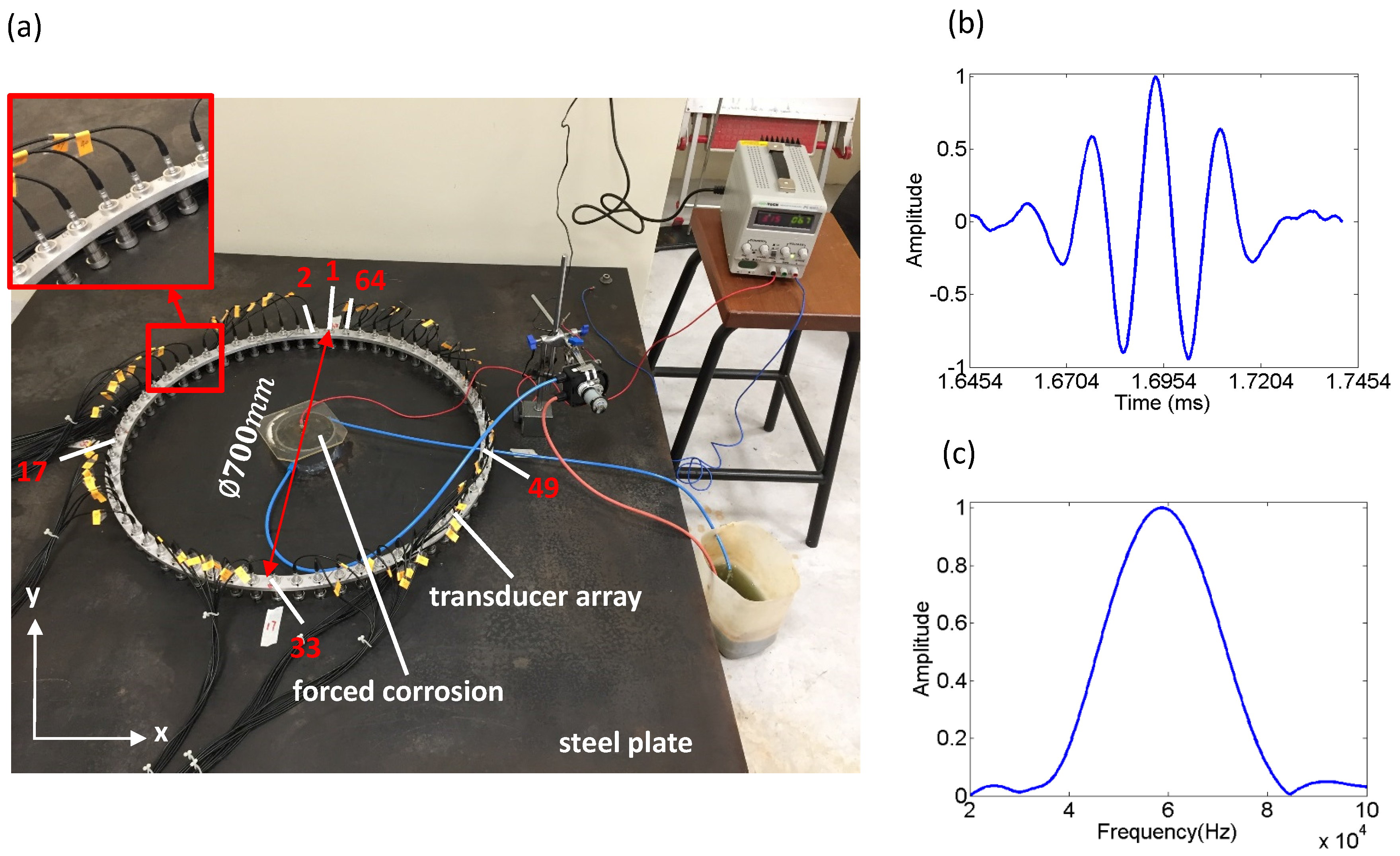
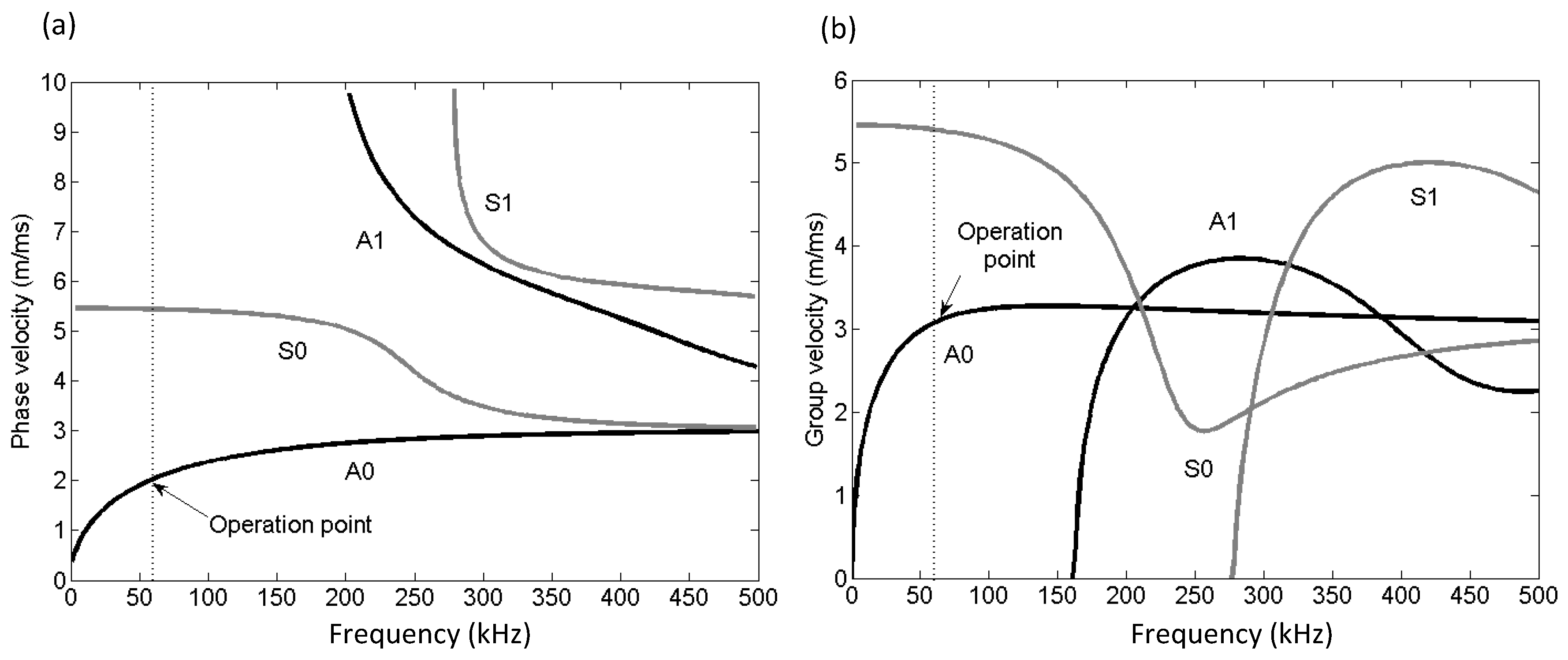
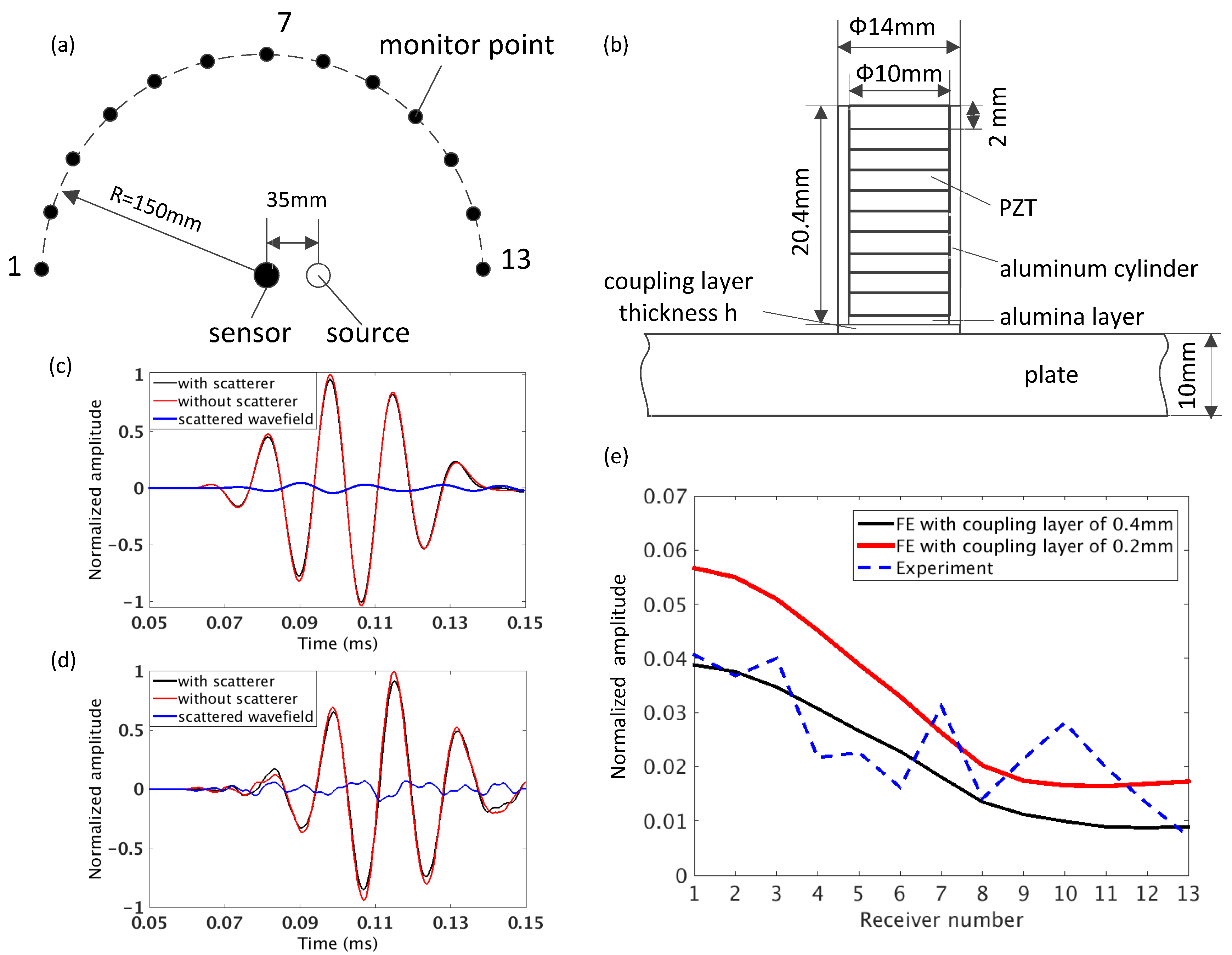
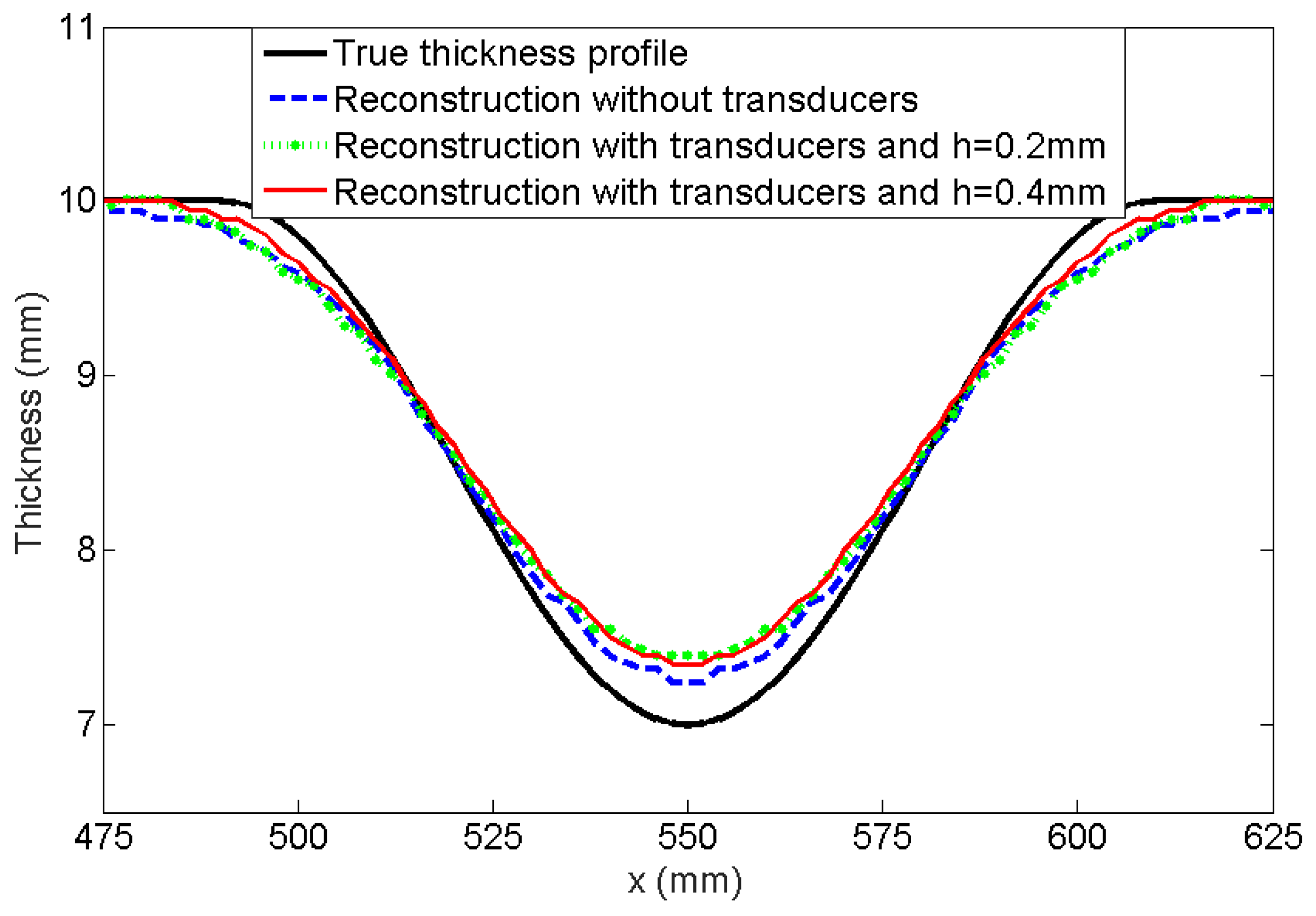
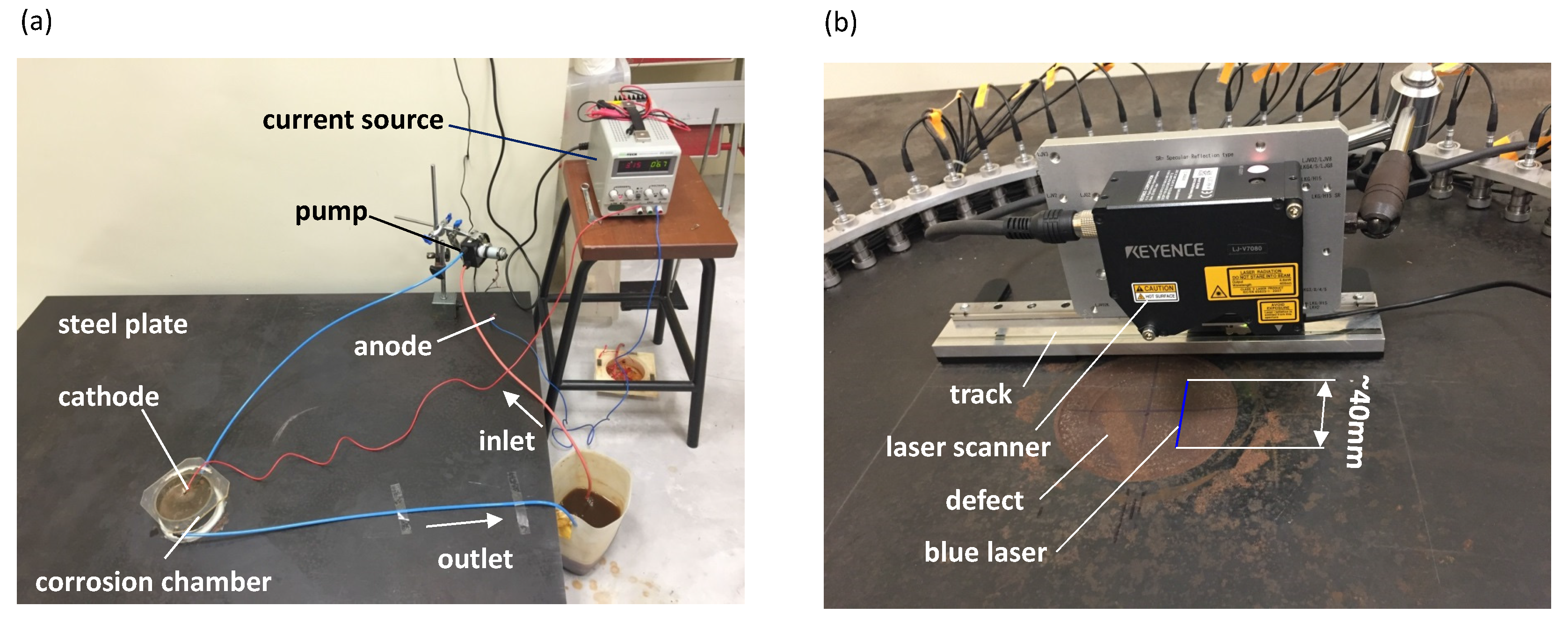
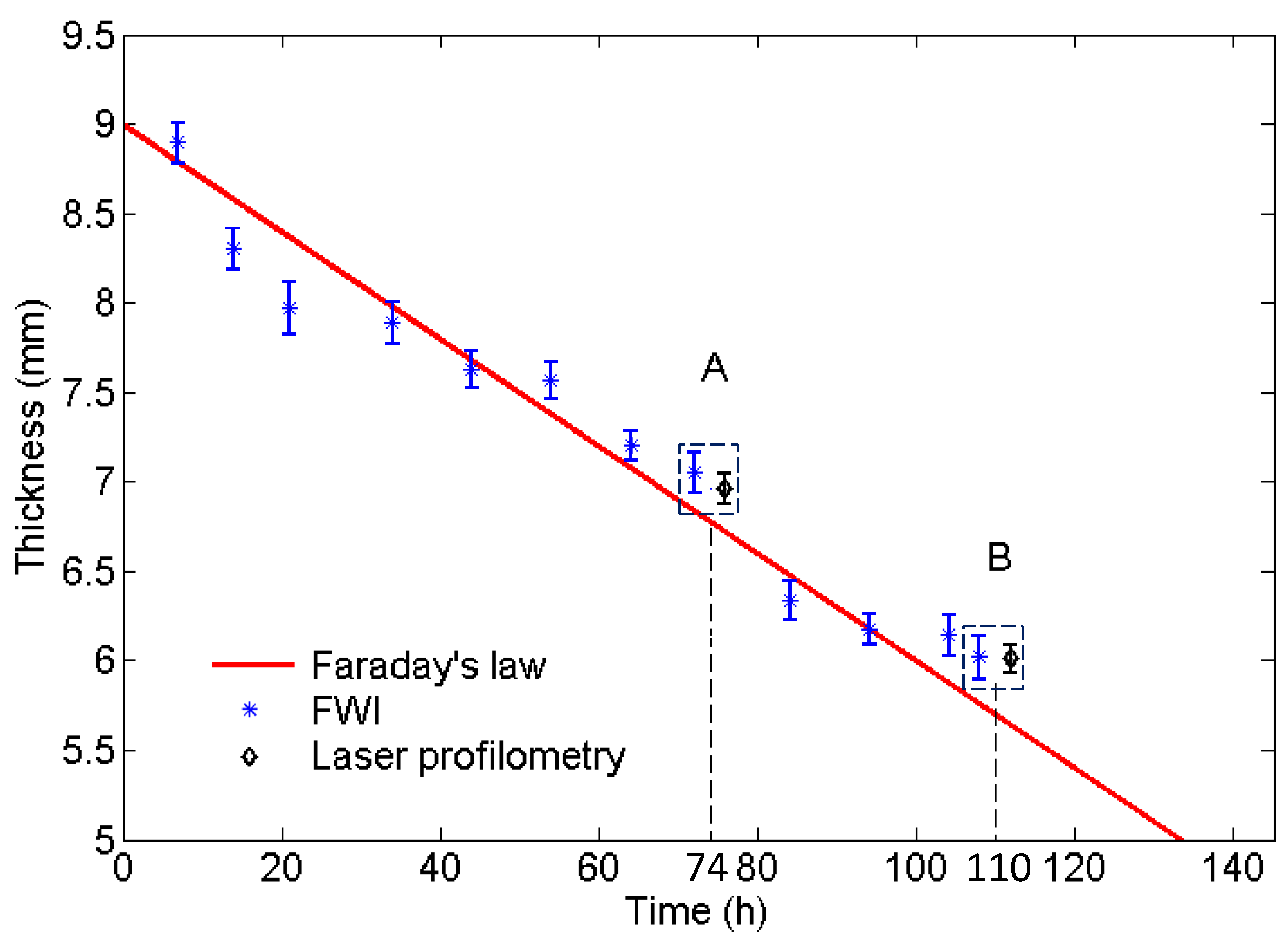
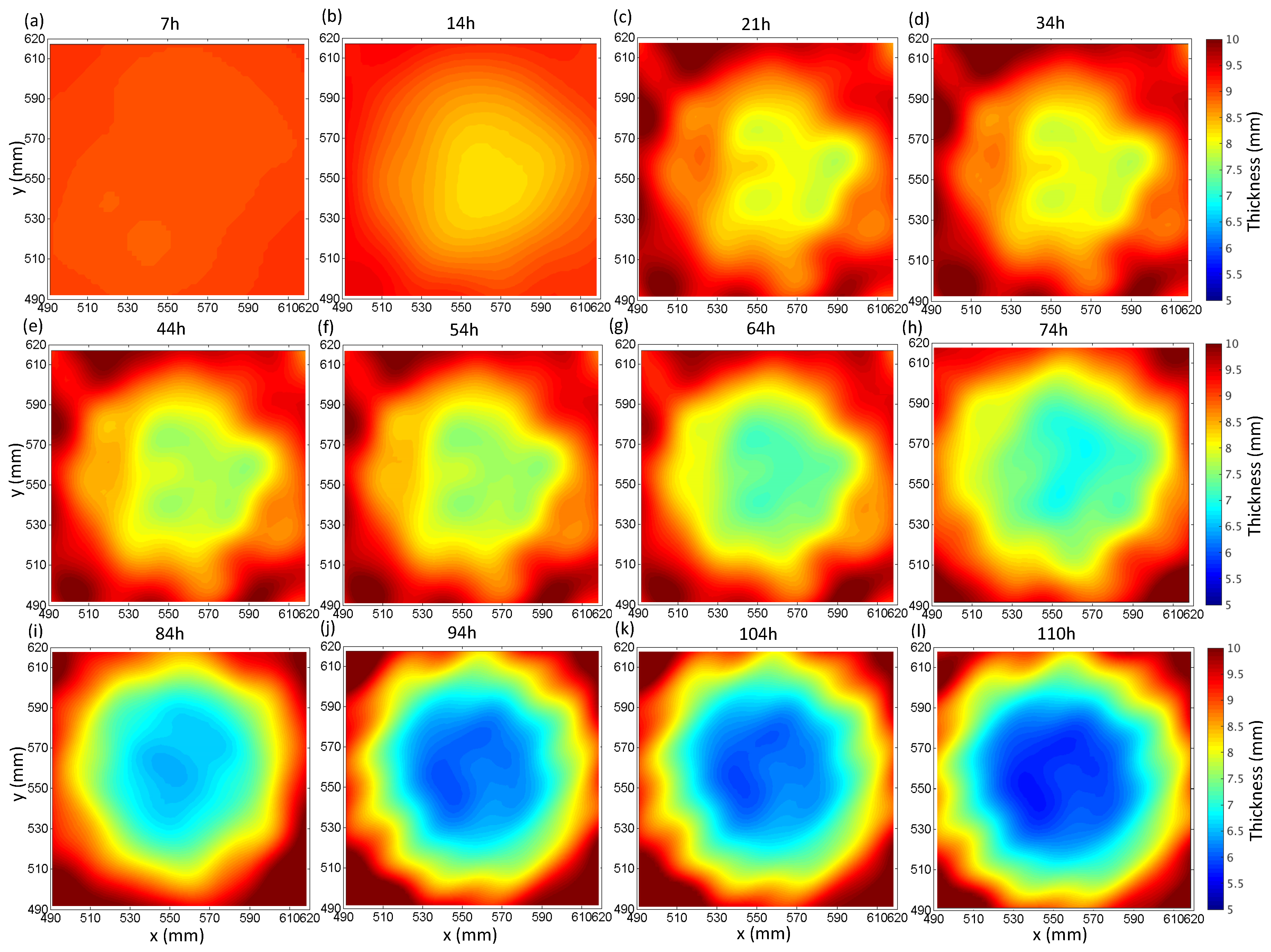
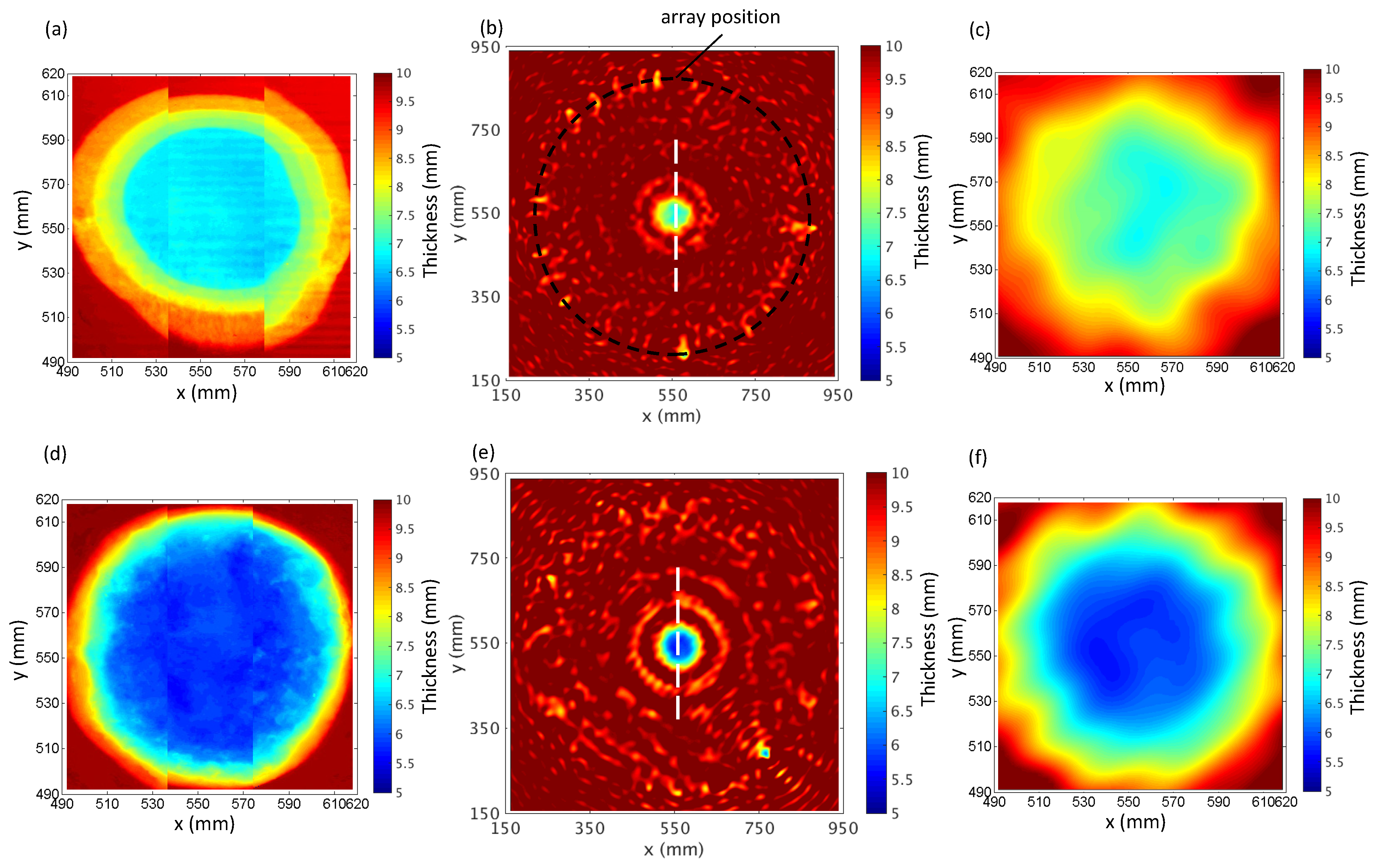
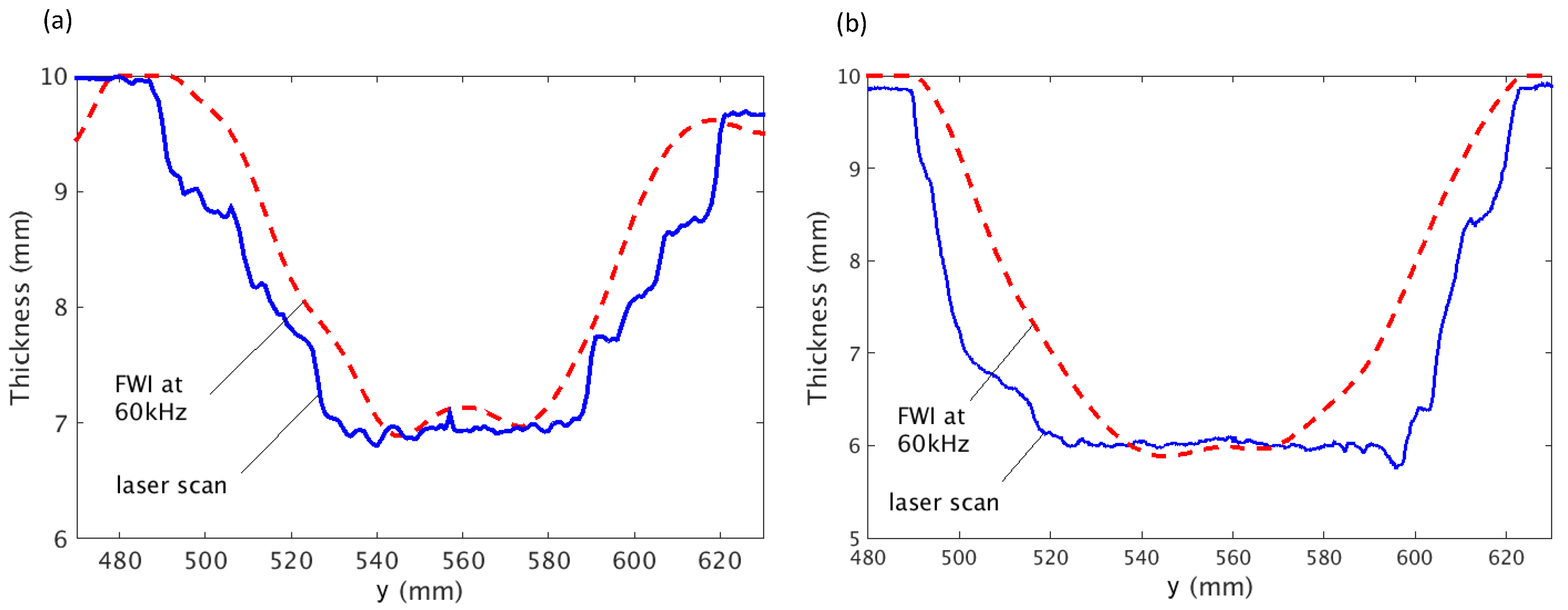
| Material | Young’s Modulus (GPa) | Poisson’s Ratio | Density (kg/m3) |
|---|---|---|---|
| Steel | 210 | 0.287 | 7850 |
| Aluminum | 70 | 0.33 | 2700 |
| Alumina | 300 | 0.21 | 3860 |
| PZT | 50 | 0.35 | 7750 |
© 2017 by the authors. Licensee MDPI, Basel, Switzerland. This article is an open access article distributed under the terms and conditions of the Creative Commons Attribution (CC BY) license (http://creativecommons.org/licenses/by/4.0/).
Share and Cite
Rao, J.; Ratassepp, M.; Lisevych, D.; Hamzah Caffoor, M.; Fan, Z. On-Line Corrosion Monitoring of Plate Structures Based on Guided Wave Tomography Using Piezoelectric Sensors. Sensors 2017, 17, 2882. https://doi.org/10.3390/s17122882
Rao J, Ratassepp M, Lisevych D, Hamzah Caffoor M, Fan Z. On-Line Corrosion Monitoring of Plate Structures Based on Guided Wave Tomography Using Piezoelectric Sensors. Sensors. 2017; 17(12):2882. https://doi.org/10.3390/s17122882
Chicago/Turabian StyleRao, Jing, Madis Ratassepp, Danylo Lisevych, Mahadhir Hamzah Caffoor, and Zheng Fan. 2017. "On-Line Corrosion Monitoring of Plate Structures Based on Guided Wave Tomography Using Piezoelectric Sensors" Sensors 17, no. 12: 2882. https://doi.org/10.3390/s17122882




